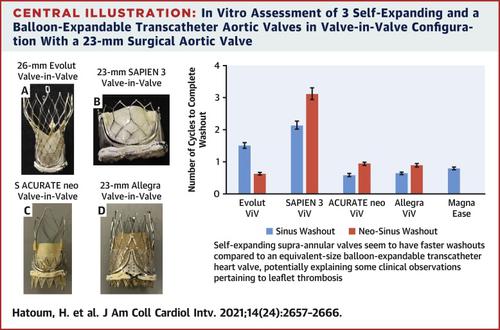JACC: Cardiovascular Interventions ( IF 11.7 ) Pub Date : 2021-11-24 , DOI: 10.1016/j.jcin.2021.09.013 Hoda Hatoum 1 , Shelley C M Gooden 2 , Janarthanan Sathananthan 3 , Stephanie Sellers 3 , Maximilian Kutting 4 , Philipp Marx 4 , Scott M Lilly 5 , Abdul R Ihdayhid 6 , Vinod H Thourani 7 , Lakshmi Prasad Dasi 2

|
Objectives
The aim of this study was to evaluate flow dynamics in the aortic sinus and the neosinus (NS) after transcatheter heart valve (THV) implantation in valve-in-valve (ViV).
Background
Leaflet thrombosis may occur on THVs and affect performance and durability. Differences in flow dynamics may affect the risk for leaflet thrombosis.
Methods
Hemodynamic assessment following THV implantation in a surgical aortic valve was performed in a left heart simulator under pulsatile physiological conditions. Assessment was performed using a 23-mm polymeric surgical aortic valve (not diseased) and multiple THV platforms, including self-expanding devices (26-mm Evolut, 23-mm Allegra, small ACURATE neo) and a balloon-expandable device (23-mm SAPIEN 3). Particle image velocimetry was performed to assess flow in the sinus and NS. Sinus and NS washout, shear stress, and velocity were calculated.
Results
Sinus and NS washout was fastest and approximately 1 cardiac cycle for each with the Evolut, ACURATE neo, and Allegra compared with the SAPIEN 3, with washout in 2 and 3 cardiac cycles, respectively. The Allegra showed the largest shear stress distribution in the sinus, followed by the SAPIEN 3. In the NS, all 4 valves showed equal likelihoods of occurrence of shear stress <1 Pa, but the Allegra showed the highest likelihoods of occurrence for shear stress >1 Pa. The velocities in the sinus and NS were 0.05, 0.078, 0.080, and 0.075 m/s for Evolut, SAPIEN 3, ACURATE neo, and Allegra ViV, respectively.
Conclusions
Sinus and NS flow dynamics differ substantially among THVs after ViV. Self-expanding supra-annular valves seem to have faster washouts compared with an equivalent-size balloon-expandable THV.
中文翻译:

自扩张和球囊扩张经导管主动脉瓣置换术后的鼻窦和鼻窦流量
目标
本研究的目的是评估经导管心脏瓣膜 (THV) 植入瓣中瓣 (ViV) 后主动脉窦和新窦 (NS) 的血流动力学。
背景
THV 上可能会发生小叶血栓形成并影响性能和耐用性。流动动力学的差异可能会影响小叶血栓形成的风险。
方法
THV 植入手术主动脉瓣后的血流动力学评估是在左心模拟器中在脉动生理条件下进行的。使用 23 毫米聚合物外科主动脉瓣(未患病)和多个 THV 平台进行评估,包括自扩张装置(26 毫米 Evolut、23 毫米 Allegra、小型 ACURATE neo)和球囊扩张装置(23-毫米智人 3)。进行粒子图像测速以评估鼻窦和 NS 中的流量。计算窦和 NS 冲洗、剪切应力和速度。
结果
与 SAPIEN 3 相比,Evolut、ACURATE neo 和 Allegra 的鼻窦和 NS 冲洗最快,每个大约 1 个心动周期,分别在 2 个和 3 个心动周期内冲洗。Allegra 在鼻窦中显示出最大的剪切应力分布,其次是 SAPIEN 3。在 NS 中,所有 4 个瓣膜都显示出相同的发生剪切应力 <1 Pa 的可能性,但 Allegra 显示出发生剪切应力 > 的最高可能性1 Pa。Evolut、SAPIEN 3、ACURATE neo 和 Allegra ViV 的窦和 NS 速度分别为 0.05、0.078、0.080 和 0.075 m/s。
结论
ViV 后 THV 之间的窦和 NS 血流动力学差异很大。与同等尺寸的球囊可扩张 THV 相比,自扩张超环瓣似乎具有更快的冲洗速度。











































 京公网安备 11010802027423号
京公网安备 11010802027423号